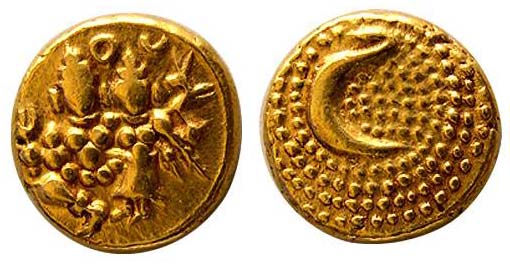

A gold coin of Tipu's father, Haider Ali: it shows Shiva and Parvati on one side, and his initial in Persian script on the other
Source:
http://www.vcoins.com/ancient/parscoins/store/viewItem.asp?idProduct=3617&large=1
(downloaded Sept. 2006)
"Mysore. Haidar Ali 1761-1782 AD. Gold Pagoda (3.41 gm; 11 mm).
Shiva
and Parvati reclining / Persian letter 'he' on a granulated field."
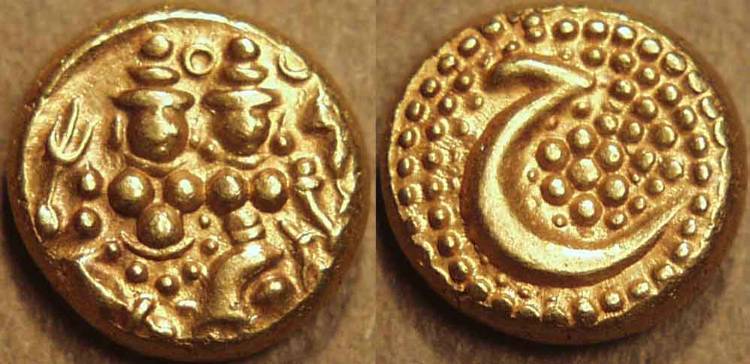
Another style of Haider Ali's gold pagodas
Source:
http://www.vcoins.com/ancient/coinindia/store/viewitem.asp?idProduct=314
(downloaded July 2007)
"KINGDOM of MYSORE: Haidar Ali Gold pagoda, Uma-Maheswara type with rosette reverse. Obverse Siva and Parvati seated facing; Siva holding trishul (trident) and mriga (deer), sun and moon above. Reverse Persian letter He (for Haidar Ali) within a granulated field; beautiful rosette within the curve of the letter. Date 1761-82. Weight 3.43 gm. Diameter 11 mm. Comments The Siva-Parvati type of Haidar Ali imitated the coins of the Ikkeri Nayakas, whom Haidar defeated in 1763. They were also the source of the gold that funded this coinage."
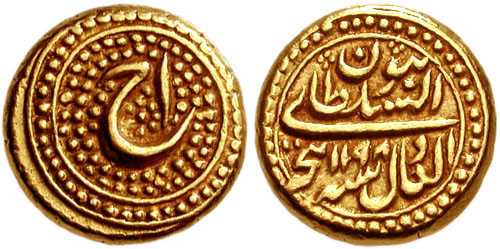
A gold pagoda from AH 1197 (1782/3), still in the name of Haidar Ali (d.1782)
Source:
http://www.cngcoins.com/Coin.aspx?CoinID=50158&IsEnlarged=1
(downloaded Jan. 2006)
"Tipu Sultan. 1782-1799. AV Pagoda (12mm, 3.41 gm). Patan mint.
Dated
AH 1197 (1782/3). Letter 'he' and year in dotted field / Legend with
date
and mint."

A "Haidari" coin from the year A.H. 1200 (1785/6), Tipu's "regnal year 4," that was later made into a pendant
Source:
http://www.vcoins.com/ancient/parscoins/store/viewItem.asp?idProduct=2612&large=1
(downloaded Mar. 2006)
"AR Haidari / Double Rupee (23.86 gm; 35 mm). Patan Mint. Dated AH 1200, Year 4. Original old mount still intact."
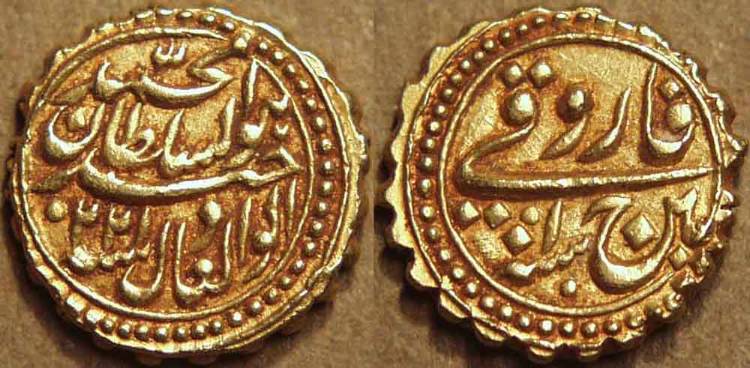
A gold pagoda from the Patan mint, dated AM 1220 (1792); the "Mauludi" dating era was instituted by Tipu in the fifth year of his reign
Source:
http://www.vcoins.com/ancient/coinindia/store/viewitem.asp?idProduct=144
(downloaded June 2007)
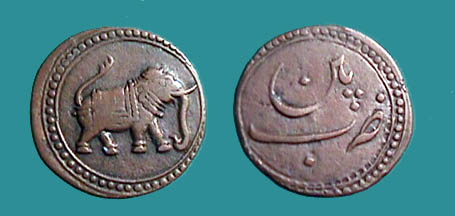
A paisa coin minted by Tipu Sultan, with an elephant on one side, a Persian inscription on the other
Source: ebay, July 2001
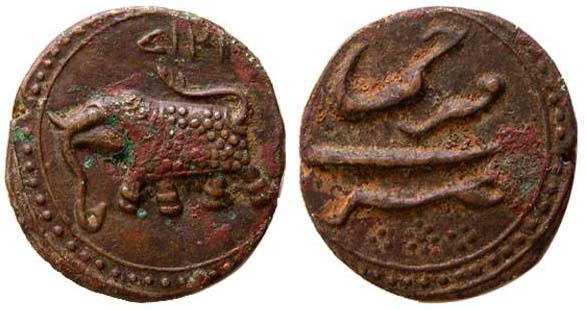
Another of Tipu's elephant coins
Source:
http://www.vcoins.com/ancient/parscoins/store/viewitem.asp?idProduct=4737
(downloaded Apr. 2007)
"KINGDOM OF MYSORE. Tipu Sultan. 1782-1799 AD. AE 1 Paisa (11.39 gm; 22 mm). Elephant advancing left / Legends. KM 53; Farrukhi (Feroke) Mint."
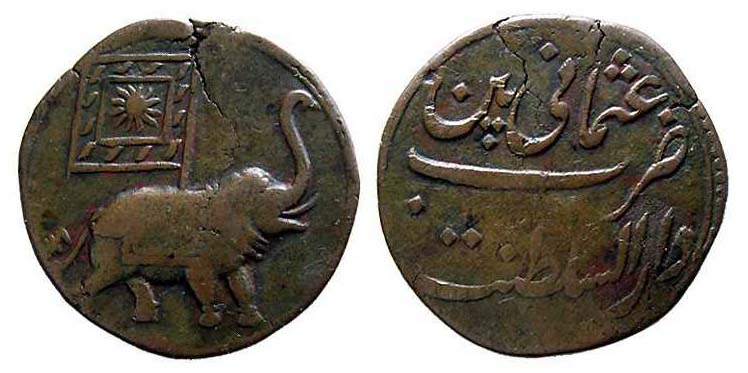
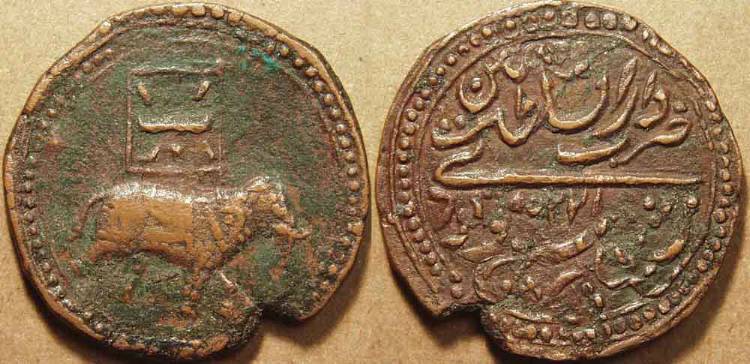
A very late double paisa coin of Tipu Sultan's, issued in AM 1225 (1797)
Source:
http://www.vcoins.com/ancient/coinindia/store/viewitem.asp?idProduct=64
(downloaded May 2007)
"Kingdom of Mysore: Tipu Sultan (1782-99) AE double paisa, Patan mint, AM 1225. Obverse Caparisoned elephant walking right, flag with Persian "Be" above. Reverse Persian legend stating date, AM 1225, and mint Patan. Date AM 1225 (=1797 CE). Weight 21.03 gm. Diameter 35 mm."
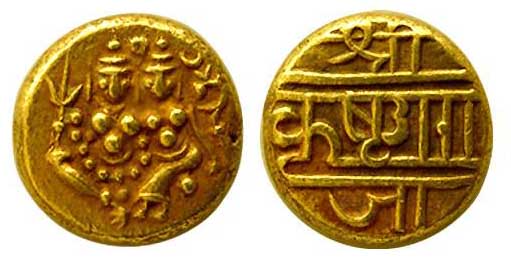
A coin issued soon after Tipu's death by his successor Krishna Raja Wodeyar, with Shiva and Parvati on one side, and the words "Shri Krishna Raja" on the other
Source:
http://www.vcoins.com/ancient/parscoins/store/viewItem.asp?idProduct=3767&large=1
(downloaded Sept. 2006)
"Mysore. 1799-1806 AD. Gold Pagoda (3.48 gm; 11 mm)."
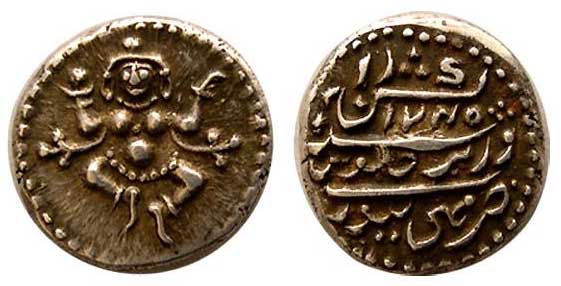
A later Mysore coin from AH 1245 (1829-30) that depicts Shiva and also uses Persian script
Source:
http://www.vcoins.com/ancient/parscoins/store/viewItem.asp?idProduct=2802&large=0
(downloaded Apr. 2006)
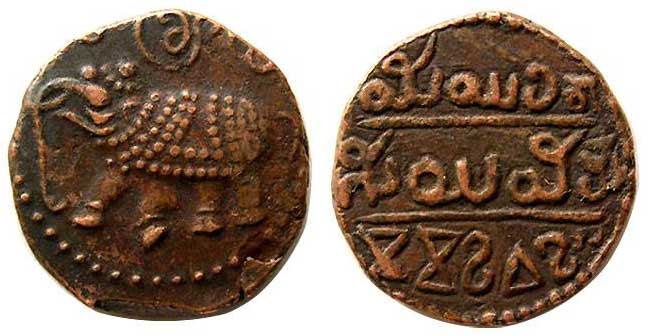
The elephant design persisted: a Mysore 20-cash coin struck c.1810-33
Source:
http://www.vcoins.com/ancient/parscoins/store/viewitem.asp?idProduct=4464
(downloaded Mar. 2007)
== Indian Routes index == Indian Routes sitemap == Glossary == FWP's main page ==